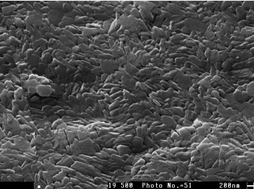Electrical properties of V2O5 thin films obtained by atomic layer deposition (ALD)
Abstract
Dielectric and conductivity

Maintenance work is planned for Wednesday 1st May 2024 from 9:00am to 11:00am (BST).
During this time, the performance of our website may be affected - searches may run slowly and some pages may be temporarily unavailable. If this happens, please try refreshing your web browser or try waiting two to three minutes before trying again.
We apologise for any inconvenience this might cause and thank you for your patience.
* Corresponding authors
a
Laboratoire de Chimie Appliquée de l'Etat Solide (LCAES), UMR 7574, ENSCP, 11 rue P. et M. Curie, 75231 Paris Cedex 05, France
E-mail:
badot@ext.jussieu.fr (J. C. Badot)
Fax: +33 1 46 34 74 89
Tel: +33 1 53 73 79 28
b Laboratoire Liquides Ioniques et Interfaces Chargées (LI2C), UMR 7612, Université P. et M. Curie, 4 Place Jussieu, Boîte 51, 75252 Paris Cedex 05, France
c Laboratoire de Génie Electrique de Paris (LGEP), UMR 8507, SUPELEC, Plateau de Moulon, 91192 Gif-sur-Yvette Cedex, France
d Laboratoire d'Electrochimie et de Chimie Analytique (LECA), UMR 7575, ENSCP, 11 rue P. et M. Curie, 75231 Paris Cedex 05, France
Dielectric and conductivity

 Please wait while we load your content...
Something went wrong. Try again?
Please wait while we load your content...
Something went wrong. Try again?
J. C. Badot, A. Mantoux, N. Baffier, O. Dubrunfaut and D. Lincot, J. Mater. Chem., 2004, 14, 3411 DOI: 10.1039/B410324F
To request permission to reproduce material from this article, please go to the Copyright Clearance Center request page.
If you are an author contributing to an RSC publication, you do not need to request permission provided correct acknowledgement is given.
If you are the author of this article, you do not need to request permission to reproduce figures and diagrams provided correct acknowledgement is given. If you want to reproduce the whole article in a third-party publication (excluding your thesis/dissertation for which permission is not required) please go to the Copyright Clearance Center request page.
Read more about how to correctly acknowledge RSC content.
 Fetching data from CrossRef.
Fetching data from CrossRef.
This may take some time to load.
Loading related content
